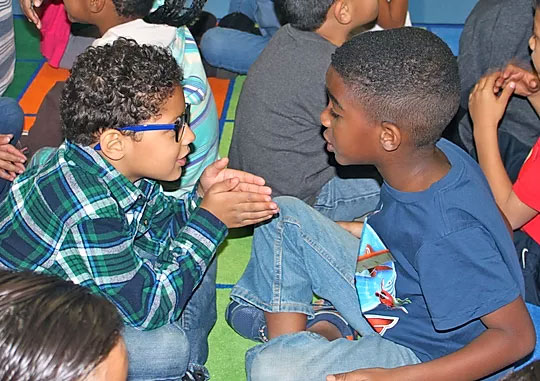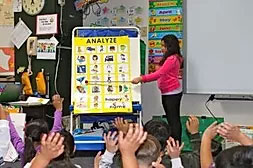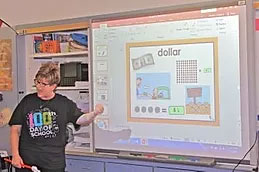Language learning program created by UC Riverside educator started in Moreno Valley and is being adopted by school districts across the U.S.

RIVERSIDE, Calif. (www.ucr.edu) — Marci Carver’s kindergartners know a lot about the word “package.” They know it contains three vowels, but one of them “doesn’t talk,” and the letter “g” sounds like a “j.” When asked about the meaning, they know a package not only comes in the mail, but is also a bundle of items that are grouped together. They have no problem packaging these thoughts into sentences.
Carver, a 27-year veteran of the Moreno Valley Unified School District (MVUSD), has never seen her students learn words and phrases so naturally. She credits their success to Project Moving Forward, a vocabulary development program created by Linda Navarrette, who directs the initiative from the University of California, Riverside’s Graduate School of Education.
Backed by a $1.9 million grant from the U.S. Department of Education, Project Moving Forward was launched in MVUSD and six other California districts in 2012 to help English language learners and other students with limited English proficiency. In Moreno Valley, the program has grown from two schools to 17, with all kindergartners now participating and four of the schools offering it through fifth grade. Nationwide, the program is now used in more than 100 schools in seven states.
According to data from MVUSD, more than 90 percent of English language learners in the program met or exceeded their annual progress goals last year, far greater than the state’s target of 62 percent. Data from 2013 showed Project Moving Forward helped close the gap in API scores between children from low income families and their peers from 12.2 percentage points to 1.9 points.
The results have been well received by Judy White, superintendent of schools in Moreno Valley.
“The research on vocabulary development in young children is very clear about the need for learning through repeated
exposure to words. In Project Moving Forward, none of this is left to chance. Every child feels like they have something to
offer and every child leaves better than when they came in,” White said.

Project Moving Forward is based on 12 years of school-based research by Navarrette, a former teacher, psychologist, and administrator with a passion for closing the education gap between English-learners and non English-learners, and advantaged and disadvantaged students.
Navarrette’s approach involves a systematic vocabulary development technique called the RULE of Three or RAP, which stands for the REHEARSE, ANALYZE and PRODUCE. It is fast-paced, interactive and puts the onus for learning on the child.
While there are variations in exactly how the material is delivered, the approximately 30-minute daily program starts when a teacher puts a word on a screen or board. The class sounds out the word together before analyzing it using a poster chart that is central to the lesson. The chart helps students identify structural components in a word, including vowels, silent letters and sounds like “ch” and “ing.” For children using the RAP approach, each word becomes a puzzle that can be solved, with teachers encouraging students as they challenge themselves to dissect new words. Using a second image-based slide, students then identify the context of each word, considering if it has more than one meaning and discussing whether it’s a verb, (can you do it?) or a noun (a person, a place or a thing). Guided by a third slide, children work in pairs to practice using the word in sentences. The group time, which includes five to eight words per session, is supported by a workbook for reading and writing practice.
Candace Jarman, a special education teacher at Moreno Valley’s Ramona Elementary School, said she “gets goosebumps” thinking about what Project Moving Forward has done for her students, half of whom she expects to join mainstream classes in record time.
“I’ve been teaching for 25 years and this is the program I’ve been looking for. The kids I teach are not only English language learners but are also in special education classes, so to see them being able to express themselves in complete sentences is phenomenal,” she said.

Carver, a kindergarten teacher at Box Springs Elementary School and an early adopter of Project Moving Forward, now helps train other teachers to use the program.
“As a teacher, I like that the students get several chances to grasp a concept and I can see their strengths and weaknesses, so I know where I need to do more work. I have kindergarten kids who are now learning on a first- or second-grade level and the process is happening very naturally,” she said.
Teachers say the program not only supports the development of vocabulary, but also critical thinking skills students will need to meet Common Core academic standards as they advance through the school system. By introducing them to concepts that are more likely to be experienced firsthand by middle- and upper-class children, the program can also help level the playing field for disadvantaged kids.
